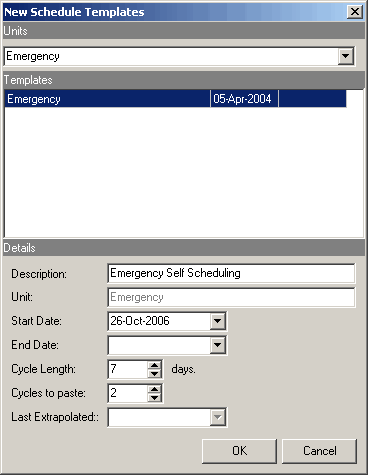Creating Templates for Self Scheduling
After you have created shift types for Self Scheduling, have given units Self Scheduling capability, and have made units and positions part of pick teams, you need to create schedule templates that use the Self Scheduling shift types.
When a schedule template is created for a unit that has Self Scheduling capability, it will contain regular shifts, and also Self Scheduling shifts. Remember that only units that appear in the Unit pane on the Self Scheduling Setup window have Self Scheduling enabled. If you are creating a template for Self Scheduling, you need to select a unit that has Self Scheduling capability.
Templates with Self Scheduling shifts must be extrapolated without gaps so that picking cycles are not disrupted.
To create a template that includes self scheduling shifts
- Open the Configuration menu, and then the Schedule window.
Alternately, click the Load Scheduling button  on the main Quadrant toolbar.
on the main Quadrant toolbar.
The Schedule window appears. - On the main Schedule window toolbar, click the arrow next to the Template button, and from the menu that appears, select New Schedule Template.

Note! A bullet indicates the last selection made from the menu. If you click the Template button, the template opens to the default (bulleted) option.
- Select a unit from the Units list box.
For Self Scheduling to work, you must select a unit that was also selected on the Self Scheduling Setup window. - Type a readily identifiable name for the template in the Description box.
- Use the date picker to select a start date for the template.
- Leave the End Date field blank unless you know that you want the template to be effective for a limited time.
- Choose a Cycle Length in days.
The cycle length determines the length of the rotation. A two-week rotation would be entered as 14 days. It is important to enter the correct value because this cannot be changed after the template is created. - In the Cycles to Paste box, select the number of cycles you want pasted to the schedule.
The system default is 1. However, some organizations like to create a schedule up to a year in advance. When you extrapolate (or paste) the template to the schedule you can change this number if you like.
- Click OK.
The new schedule template appears, ready for adding rows, associating employees to the rows, and plotting shifts.

